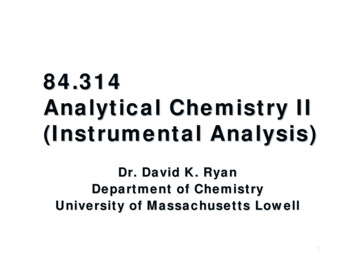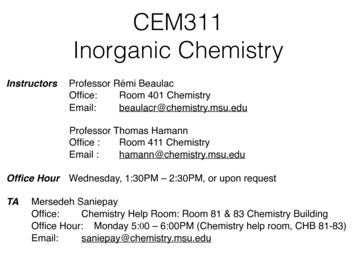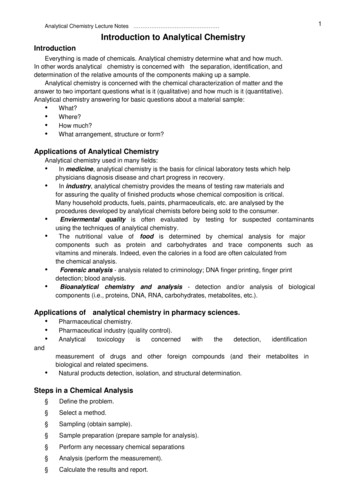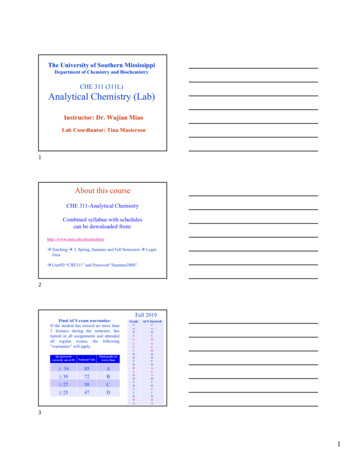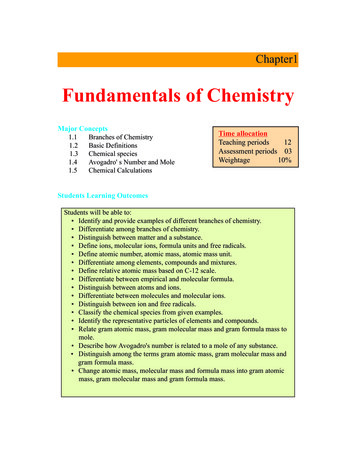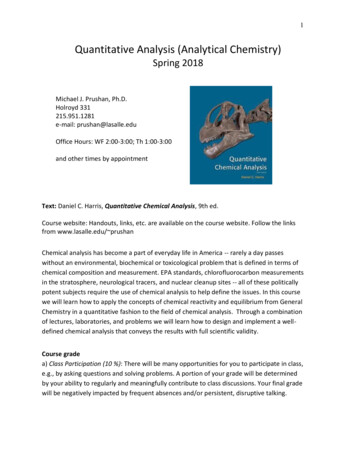
Transcription
1Quantitative Analysis (Analytical Chemistry)Spring 2018Michael J. Prushan, Ph.D.Holroyd 331215.951.1281e-mail: prushan@lasalle.eduOffice Hours: WF 2:00-3:00; Th 1:00-3:00and other times by appointmentText: Daniel C. Harris, Quantitative Chemical Analysis, 9th ed.Course website: Handouts, links, etc. are available on the course website. Follow the linksfrom www.lasalle.edu/ prushanChemical analysis has become a part of everyday life in America -- rarely a day passeswithout an environmental, biochemical or toxicological problem that is defined in terms ofchemical composition and measurement. EPA standards, chlorofluorocarbon measurementsin the stratosphere, neurological tracers, and nuclear cleanup sites -- all of these politicallypotent subjects require the use of chemical analysis to help define the issues. In this coursewe will learn how to apply the concepts of chemical reactivity and equilibrium from GeneralChemistry in a quantitative fashion to the field of chemical analysis. Through a combinationof lectures, laboratories, and problems we will learn how to design and implement a welldefined chemical analysis that conveys the results with full scientific validity.Course gradea) Class Participation (10 %): There will be many opportunities for you to participate in class,e.g., by asking questions and solving problems. A portion of your grade will be determinedby your ability to regularly and meaningfully contribute to class discussions. Your final gradewill be negatively impacted by frequent absences and/or persistent, disruptive talking.
2Please note: Cell phones and pagers must be turned off or placed in silent mode at thebeginning of class as a courtesy to everyone in the class. Grade penalties of 5-25 points mayalso be applied for failing to follow this policy.b) Quizzes (20 %): Short in-class quizzes will be given about once a week. The questionformat will include short answer and problems. The lowest quiz will be dropped. No makeup quizzes will be available and missed quizzes will count as a zero.c) Exams (10 % each): Three exams will be given in class. Exam questions will take the formof short answer, and/or problem solving formats. Although homework problems will helpyou prepare for the exam, It will generally be the case that the exam questions will testwhat you have LEARNED, by asking you to apply your knowledge. It is therefore importantthat you UNDERSTAND what you are doing and that you do not just memorize variousproblem types. There are no make–up exams. Only official documentation confirming legalor medical emergencies will be considered.d) Final Exam (15 %): A final comprehensive exam, which is about double the number ofquestions as the in class exams.e) Laboratory (30 %): Your grade is based on your written lab reports as well as yourperformance in the laboratory (techniques and accuracy).Note: In order to receive a passing grade for Analytical Chemistry you MUST pass both thelecture and laboratory portions of the course!The actual grade will be based on the grading scale given below:A90%B80%C70%D60%For final grades, The /- system is used (B , A-, etc.) and breaks between half letter gradeswill be within the above grade ranges and made at the discretion of the instructor.Homework: I expect you to read the assigned sections and homework problems from thetextbook. Homework problems are not collected; it is your responsibility to complete yourwork. It is important that you do your homework. The more you do, the more you will learn.From time to time assignments, which will be submitted, will be handed out. These aremeant to check your progress in the course. Chemistry cannot be efficiently learnedwithout working problems, and you will not realize what you do not know until you try todo a problem. Most students, who do poorly in this course neglect to do homework! I amhappy to help you outside of class. You may consult with me as often as you wish; Iencourage it. Please consult early rather than waiting just before a test; it will be better foryour learning. In order to compete successfully in this course, you will need to spend at
3least 12–15 hours per week studying chemistry. There is ample research which provesthat students who study together perform considerably better than those who study alone.You are encouraged to find fellow students interested in spending at least a portion of theirstudy time with others. If you know of no other student taking this course, I will be happy toassist your efforts by making a class announcement for other interested person(s) to meetwith you after class. All of us rely on our senses for the learning process. However, theextent to which we rely on sight, sound, even touch and smell differs from person toperson. You are encouraged to assess your own learning style preference and capitalize onthe approach best suited for you.Academic Integrity: It is your responsibility to maintain a high degree of integrity in yourwork. Cheating of any kind will not be tolerated and will result in a failure in the course! Thefollowing are considered cheating: (a) Sharing of results and answers on lab reports, gradedassignments, quizzes and exams; (b) Use of unauthorized materials during an exam; (c)Plagiarism, including copying a fellow student’s lab report or homework. When in doubt,both parties involved in plagiarism will be held responsible for the integrity violation. Pleaserefer to the school’s official Academic Integrity Policy for further information.Students with disabilities: Students with disabilities should refer to the student handbookfor resources that are available to them as well as compliance with the American DisabilitiesAct. La Salle University also works with students requesting academic accommodations ona case-by-case basis through an interactive process to determine the appropriateaccommodations. Students who would like to request academic accommodations mustsubmit the appropriate documentation certifying an illness or condition. To learn moreabout the process for requesting academic accommodations, please contact Rose LeePauline, Affirmative Action Officer, at pauline@lasalle.edu or 215.951.1014.Syllabus Change Policy: This syllabus is a guide and every attempt is made to provide anaccurate overview of the course. However, circumstances and events may make itnecessary for the instructor to modify the syllabus during the semester and may depend, inpart, on the progress, needs, and experiences of the students. The instructor will give noticewhen changes to the syllabus are made.
4Course Topics Outline:WeekChaptersTopicsHW ProblemsCh. 0The Analytical Process0-1Ch. 1Measurements1-14, 1-15, 1-16, 1-24,1-27, 1-31, 1-32, 1-34Ch. 2Tools of the Trade2-10, 2-16, 2-23(c)Ch. 3Experimental Error3-1, 3-2, 3-5, 3-13, 3-153Ch. 4StatisticsEx 4-A, 4-B, 4-F, 4-12, 4-22,4-244Ch. 6Chemical EquilibriumCh. 7Let the Titrations BeginCh. 8Activity and Systematic125EquilibriumEx 6-G, 6-I, 6-K(a); Problems 6-18, 6-19,6-20, 6-21, 6-28, 6-29, 6-30 6-32,6-367-1, 7-2, 7-4Ex 8-A, 8-C, 8-F, 8-G, 8-H, 81, 8-4, 8-9, 8-10, 8-11, 8-12,8-18, 8-23, 8-24Examination I6Ch. 97Ch. 10 Polyprotic Acid-Base Equilibrium10-4, 10-5, 10-6, 10-16, 1027, 10-38, 10-40Ch. 11 Acid-Base Titration11-1, 11-3, 11-4, 11-10, 1112, 11-17, 11-29Ch. 12 EDTA Titrations12-1, 12-2, 12-38Monoprotic Acid-Base EquilibriumEx 9-B, 9-C, 9-D, 9-F, 9-G, 95, 9-6, 9-11, 9-12, 9-21, 930, 9-32, 9-35, 9-36, 9-38,9-41Examination II910Ch. 14 Fundamentals of ElectrochemistryEx 14-B, 14-K, 14-2, 14-3,14-13, 14-14, 14-17(a-b),14-21, 14-29, 14-31
5WeekChaptersTopicsHW Problems11Ch. 15 Electrodes and Potentiometry15-6, 15-27, 15-3812Ch. 16 Redox Titrations16-26, 16-30Examination III13Ch. 17 Electroanalytical Techniques15Catch up and REVIEW16Final Examination17-2, 17-38
e) Laboratory (30 %): Your grade is based on your written lab reports as well as your performance in the laboratory (techniques and accuracy). Note: In order to receive a passing grade for Analytical Chemistry you MUST pass both the lecture and laboratory portions of the course! The actual grade will be based on the grading scale given below:




